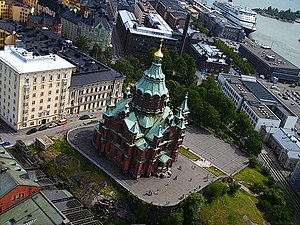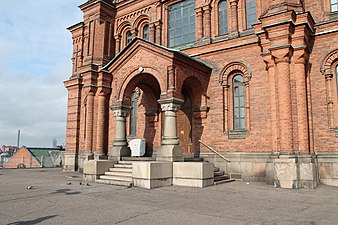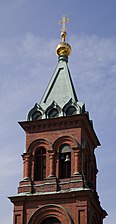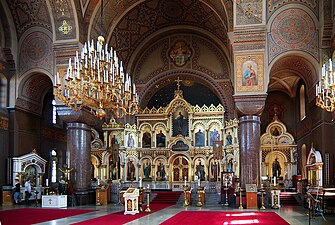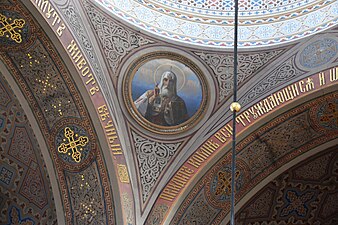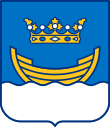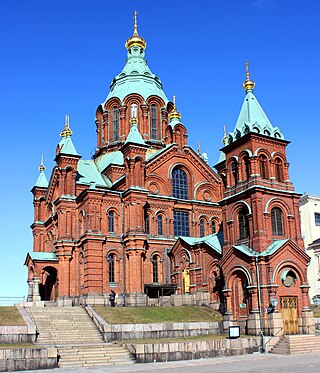
The Orthodox Church of Finland or Finnish Orthodox Church is an autonomous Eastern Orthodox archdiocese of the Ecumenical Patriarchate of Constantinople. The church has a legal position as a national church in the country, along with the Evangelical Lutheran Church of Finland.

The Cathedral of the Dormition, also known as the Assumption Cathedral or Cathedral of the Assumption, is a Russian Orthodox church dedicated to the Dormition of the Theotokos. It is located on the north side of Cathedral Square of the Moscow Kremlin in Russia, where a narrow alley separates the north from the Patriarch's Palace with the Twelve Apostles Church. Separately in the southwest, also separated by a narrow passage from the church, stands the Palace of Facets. The cathedral is regarded as the mother church of Muscovite Russia.

Helsinki Cathedral is the Finnish Evangelical Lutheran cathedral of the Diocese of Helsinki, located in the neighborhood of Kruununhaka in the centre of Helsinki, Finland, at the Senate Square. The church was originally built from 1830 to 1852 as a tribute to the Grand Duke of Finland, Tsar Nicolas I. It was also known as St Nicholas's Church until Finland declared its full independence in 1917. It is a major landmark of the city, and one of the most famous historical structures in Finland as a whole when viewed globally.

Kazan Cathedral or Kazanskiy Kafedralniy Sobor, also known as the Cathedral of Our Lady of Kazan, is a cathedral of the Russian Orthodox Church on the Nevsky Prospekt in Saint Petersburg. It is dedicated to Our Lady of Kazan, one of the most venerated icons in Russia.

August 14 - Eastern Orthodox liturgical calendar - August 16

The Dormition of the Mother of God Cathedral is the largest church building in Varna and the third largest cathedral in Bulgaria. Officially opened on 30 August 1886. It is the residence of the bishopric of Varna and Preslav and one of the symbols of Varna.

Klaukkala is the southern-most urban area of the Nurmijärvi municipality in Uusimaa, Finland, located near Lake Valkjärvi. It is the largest urban area in Nurmijärvi, and despite the fact that it officially has the status of a village, it is often mistakenly thought to be a separate town due to its size and structure. In the 2010s, Klaukkala's urban area grew to be part of the larger Helsinki urban area.
Cathedral of the Dormition of the Theotokos or Cathedral of the Dormition of the Mother of God may refer to:

The Holy Trinity Church is a Finnish Orthodox Church located in the Kruununhaka district of Helsinki, on the corner of Unioninkatu and Rauhankatu. The church was built in the neo-classical style in 1826 under the direction of the architect Carl Ludvig Engel, and was dedicated and opened in the following year. The Holy Trinity services the city's orthodox community with Divine Liturgy held in both Church Slavic and Finnish.
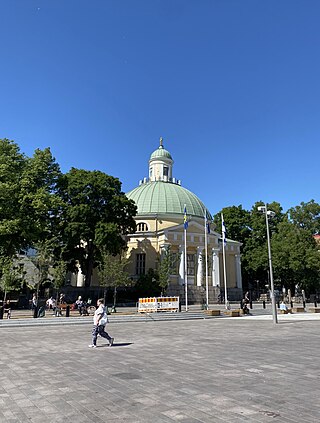
Turku Orthodox Church or the Church of the Holy Martyr Empress Alexandra is the main church of the Turku Orthodox parish located at the northwest corner of the Turku Market Square along the Yliopistonkatu street in Turku, Finland. The church was built under plans drafted by architect Carl Ludvig Engel and was ordered by Nicholas I of Russia on 5 January 1838. Construction, which began in 1839, cost 67,886 rubles and was completed in 1845. The church was consecrated on 2 September 1845. The church was dedicated to Alexandra, the spouse of Diocletian who had publicly become Christianised and suffered a martyr's death on 23 April 303. The choice of patron saint may have been due to Nicholas I's wife's name, Aleksandra Feodorovna.

The Old Church of Helsinki, designed by Carl Ludvig Engel and completed in 1826, is an Evangelical Lutheran church in Helsinki. The oldest existing church in central Helsinki, the church was originally planned as a temporary building as the Ulrika Eleonora Church constructed in 1727 had become too small for the congregation and the new church, Helsinki Cathedral, would not be completed until 1852. However, the city's rapid population growth from the early 19th century onwards ensured that the church would remain needed, and also necessitated the construction of many other churches.
Juutila Foundry is the oldest working bell foundry in Finland. Juutila foundry was founded in 1881.

The Russian Orthodox Church in Finland is a semi-autonomous part of the Russian Orthodox Church formed in 1926. An official headquarters of the Moscow Patriarchate, led by Father Viktor Lyutik, was opened in Helsinki in 1999.

Ambrosius is the retired Metropolitan of Helsinki. He matriculated from the Joensuu Lyceum in 1964. He completed the degree of Master of Theology at Helsinki University in 1968. He also completed the degree of Master of Political Science in 1972.

The St. Nicholas Church is the main church of the Kotka Orthodox Church in Kotka, Finland, surrounded by the Isopuisto park The church was built between 1799 and 1801 according to the drawings of architect Jakov Perrin. The church dates back to the time of the active years of the sea fortress of Ruotsinsalmi, when the Russians built the Ruotsinsalmi–Kyminlinna double fortress in the Kymi parish and a fortress town was created on Kotkansaari. The church is the oldest building in present-day Kotka, and it is a notable representative of neoclassicism in Finland.

St. Nicholas Cathedral is the main church of the Kuopio Orthodox Parish in Väinölänniemi, Kuopio, Finland, and also the seat of the Orthodox Diocese of Karelia. The church was completed in 1903 and is dedicated to the memory of Saint Nicholas. The church, built between 1902 and 1903, was designed by the master builder Aleksander Isakson from Vyborg. The facade is plastered and painted to look like red brick, but there is also genuine brick under the plaster. In appearance, it resembles red-brick simultaneous garrison churches. The iconostasis was made at the Alexander Nevsky Lavra in Saint Petersburg and was donated by Nikolay Bobrikov, the Governor-General of Finland. There are eight bells in the cathedral.

Bishop Sergei is the vicar bishop of the Helsinki Orthodox Diocese, with the title of Bishop of Hamina. He was consecrated in January 2022. Before this, he served as the hegumen of the New Valamo monastery during 1997–2011 and 2012–2021).
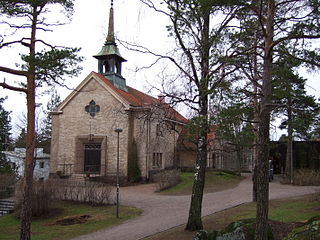
Kulosaari Church is a Lutheran church located in the Kulosaari suburb of Helsinki, Finland.

The Order of the Holy Lamb is a semi-official ecclesiastical order of Finland awarded by the Orthodox Church of Finland. Under the patronage of the Finnish state, its Grand Master is the Archbishop of the Orthodox Church of Finland. The order can be awarded to anyone regardless of religion or nationality who have made services to the Church.

The Klaukkala Orthodox Church, also known as St. Nectarios Church, is the 20th-century wooden Orthodox church located in Klaukkala, an urban area in the Nurmijärvi municipality in Uusimaa, Finland. The church was named after the Greek saint Nectarios of Aegina. The church also keeps the relic of Nectarios.









